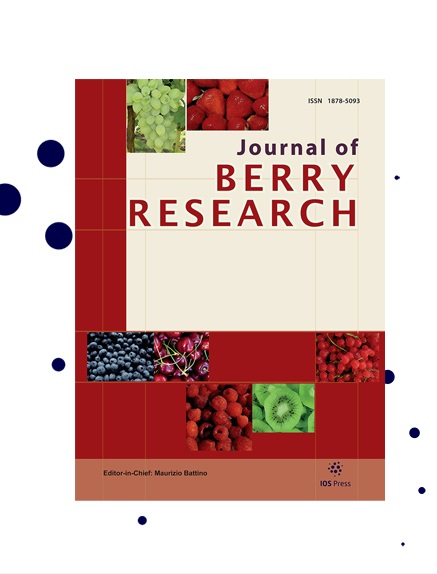Investigation of the impact of black chokeberry polyphenols in different matrices on the human gut microbiota using the in vitro model of the large intestine (TIM-2)
IF 1.4
4区 农林科学
Q3 PLANT SCIENCES
引用次数: 0
Abstract
BACKGROUND: Despite the great range of health-beneficial activities associated with dietary polyphenols, their influence on gut ecology remains poorly understood. Only a few studies have examined the impact of black chokeberry polyphenols present in different matrices on human gut microbiota, and in fact none have examined encapsulated black chokeberry polyphenols. OBJECTIVE: The objective of this study was to evaluate the effect of black chokeberry polyphenols in pulp, extract and encapsulate (in a maltodextrin:gum Arabic polymer system) on human gut microbiota and fecal short-chain and branched-chain fatty acids (SCFA and BCFA, respectively). METHODS: The effect of black chokeberry polyphenols on gut microbiota was tested in a validated, dynamic in vitro model of the colon (TIM-2) for 24 h by applying five different interventions (Pulp, Extract, Encapsulate, Encapsulate control, SIEM) to the standardized microbiota from five healthy donors. RESULTS: We observed that the fermentation of black chokeberry polyphenols in the in vitro colon model (TIM-2) resulted in shifts in the standardized microbiota and differentiation in the extent of the production of SCFA and BCFAs. Synergy between maltodextrin+gum Arabic+polyphenols resulted in an increase in the relative abundances of some health-promoting taxa and decrease in the disease related taxa Alistipes. Encapsulation increased the SCFA production and decreased the BCFA production in the lumen. CONCLUSIONS: Although encapsulation of polyphenols may provide a robust way for their protection, their effect on the gut microbiota should be further investigated both by using different coating materials and with in vivo studies.利用体外大肠模型(TIM-2)研究不同基质黑莓多酚对人肠道微生物群的影响
背景:尽管膳食多酚具有广泛的有益健康的活性,但它们对肠道生态的影响仍然知之甚少。只有少数研究调查了存在于不同基质中的黑莓多酚对人体肠道微生物群的影响,事实上,没有人调查过胶囊化的黑莓多酚。目的:本研究的目的是评估黑莓果肉、提取物和包封物(麦芽糊精:阿拉伯胶聚合物体系)中多酚对人体肠道微生物群和粪便短链和支链脂肪酸(分别为SCFA和BCFA)的影响。方法:在一个经过验证的、动态的体外结肠模型(TIM-2)中,通过对5名健康供体的标准化微生物群应用5种不同的干预措施(果肉、提取、封装、封装对照、SIEM),测试黑莓多酚对肠道微生物群的影响。结果:我们观察到黑莓多酚在体外结肠模型(TIM-2)中的发酵导致了标准化微生物群的变化和SCFA和BCFAs生产程度的分化。麦芽糖糊精+阿拉伯胶+多酚的协同作用导致一些促进健康的分类群的相对丰度增加,而与疾病相关的分类群的相对丰度减少。胶囊化增加了管腔内SCFA的产生,减少了BCFA的产生。结论:尽管多酚包封可能提供了一种强有力的保护方式,但它们对肠道微生物群的影响还需要通过使用不同的包封材料和体内研究来进一步研究。
本文章由计算机程序翻译,如有差异,请以英文原文为准。
求助全文
约1分钟内获得全文
求助全文
来源期刊

Journal of Berry Research
Biochemistry, Genetics and Molecular Biology-Biochemistry
CiteScore
3.50
自引率
11.80%
发文量
21
期刊介绍:
The main objective of the Journal of Berry Research is to improve the knowledge about quality and production of berries to benefit health of the consumers and maintain profitable production using sustainable systems. The objective will be achieved by focusing on four main areas of research and development:
From genetics to variety evaluation
Nursery production systems and plant quality control
Plant physiology, biochemistry and molecular biology, as well as cultural management
Health for the consumer: components and factors affecting berries'' nutritional value
Specifically, the journal will cover berries (strawberry, raspberry, blackberry, blueberry, cranberry currants, etc.), as well as grapes and small soft fruit in general (e.g., kiwi fruit). It will publish research results covering all areas of plant breeding, including plant genetics, genomics, functional genomics, proteomics and metabolomics, plant physiology, plant pathology and plant development, as well as results dealing with the chemistry and biochemistry of bioactive compounds contained in such fruits and their possible role in human health. Contributions detailing possible pharmacological, medical or therapeutic use or dietary significance will be welcomed in addition to studies regarding biosafety issues of genetically modified plants.
 求助内容:
求助内容: 应助结果提醒方式:
应助结果提醒方式:


